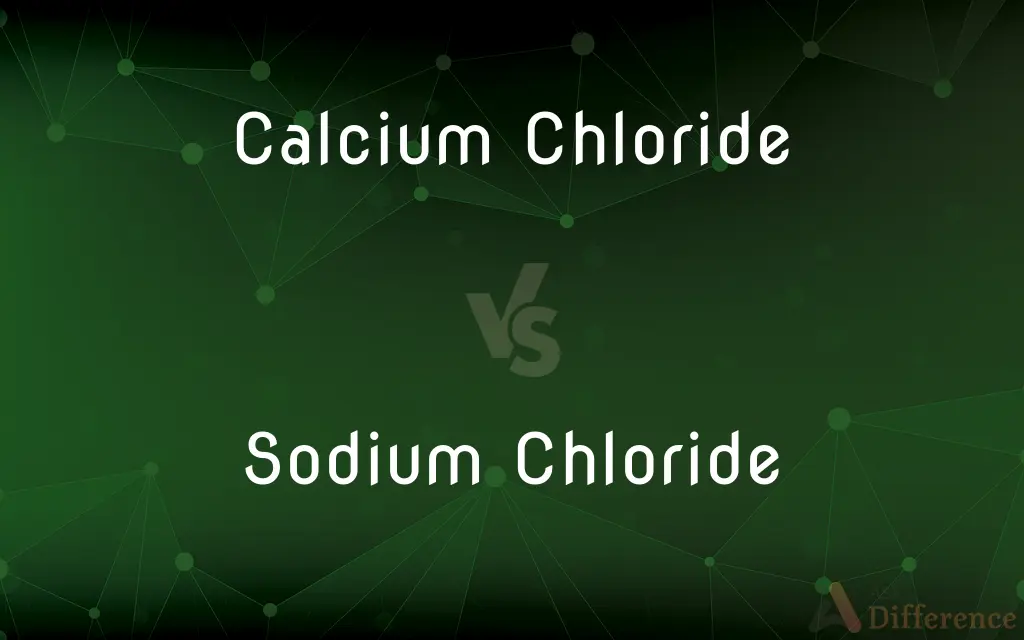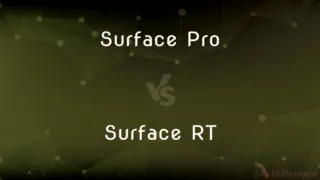Calcium Chloride vs. Sodium Chloride — What's the Difference?
By Tayyaba Rehman & Urooj Arif — Published on February 22, 2024
Calcium chloride, a hygroscopic salt used for de-icing and dust control, with high solubility and moisture absorption. Sodium chloride, common table salt, is primarily used for seasoning food and winter road de-icing, with lower solubility and absorption.

Difference Between Calcium Chloride and Sodium Chloride
Table of Contents
ADVERTISEMENT
Key Differences
Calcium chloride (CaCl2) is highly valued for its ability to absorb moisture from the environment, making it an excellent desiccant. Its hygroscopic nature allows it to lower the freezing point of water more effectively than sodium chloride (NaCl), which is why it is often used for de-icing roads in colder climates and controlling dust on unpaved roads.
Sodium chloride, on the other hand, is most commonly recognized as table salt, used extensively in cooking and food preservation. Its role in de-icing is significant but less efficient compared to calcium chloride due to its lower efficacy in extreme cold. NaCl is also less hygroscopic, which limits its use in moisture control applications.
In terms of solubility, calcium chloride outperforms sodium chloride, dissolving more readily in water, which contributes to its effectiveness in lowering the freezing point of water. This characteristic makes CaCl2 a preferred choice for rapid de-icing and for use in brine solutions in various industrial processes.
Despite their different applications, both salts play crucial roles in their respective domains. CaCl2's utility extends to the food industry as a firming agent and in the manufacturing of plastics, while NaCl's ubiquity in culinary practices and food preservation is unparalleled. Their distinct chemical and physical properties dictate their suitability for various tasks.
The environmental impact of these salts also differs; calcium chloride is generally considered less harmful to vegetation and concrete surfaces compared to sodium chloride, which can cause soil and water salinization and infrastructure corrosion. This aspect influences their application in areas sensitive to ecological and material damage.
ADVERTISEMENT
Comparison Chart
Chemical Formula
CaCl2
NaCl
Hygroscopic Nature
Highly hygroscopic, absorbs moisture from the air
Less hygroscopic, limited moisture absorption
Solubility in Water
Highly soluble, effective in lowering water's freezing point
Moderately soluble, less effective in extreme cold
Primary Use
De-icing, dust control, desiccant
Seasoning, food preservation, de-icing
Environmental Impact
Less damaging to vegetation and concrete
Can cause soil and water salinization, corrosive to metals
Compare with Definitions
Calcium Chloride
Serves as a firming agent in the food industry.
Calcium chloride is added to canned vegetables to keep them crisp.
Sodium Chloride
Commonly known as table salt, used for seasoning.
Sodium chloride is essential in every kitchen for enhancing flavor.
Calcium Chloride
Known for its moisture-absorbing properties.
Calcium chloride packets are included in packaging to reduce humidity.
Sodium Chloride
Used in industrial processes, like chlorine production.
Sodium chloride is electrolyzed to produce chlorine gas in chemical plants.
Calcium Chloride
Utilized in dust control on roads.
Spraying calcium chloride helps to keep dust levels down on gravel roads.
Sodium Chloride
Essential in regulating body fluids.
Sodium chloride in the diet is crucial for maintaining hydration balance.
Calcium Chloride
Used in concrete to accelerate setting.
Adding calcium chloride to concrete mixtures speeds up the hardening process.
Sodium Chloride
Employed in de-icing roads during winter.
Trucks spread sodium chloride on highways to melt snow and ice.
Calcium Chloride
A highly soluble salt used for de-icing.
The city used calcium chloride on roads to prevent ice formation.
Sodium Chloride
Acts as a preservative in food.
Sodium chloride is used to cure meats and preserve pickles.
Common Curiosities
Can sodium chloride be used for moisture control?
Sodium chloride has limited moisture-absorbing capabilities compared to calcium chloride, making it less effective for this purpose.
Why is sodium chloride so widely used in food?
Sodium chloride is essential for flavor enhancement and food preservation, making it a staple in culinary practices worldwide.
Can calcium chloride damage concrete or vegetation?
Calcium chloride is generally considered less harmful to vegetation and concrete than sodium chloride, but excessive use can still cause damage.
Is calcium chloride safe for consumption?
In small amounts, calcium chloride is safe and commonly used as a food additive; however, like any chemical, excessive consumption is not recommended.
Why is calcium chloride better for de-icing than sodium chloride?
Calcium chloride is more effective because it's highly soluble, hygroscopic, and lowers the freezing point of water more efficiently.
Is sodium chloride harmful to the environment?
Excessive use of sodium chloride can lead to soil and water salinization and is corrosive to metals, posing environmental and infrastructural risks.
Can either salt be used in firefighting?
Calcium chloride can be used in firefighting as it absorbs heat, but sodium chloride is not commonly used for this purpose.
How do the costs of calcium chloride and sodium chloride compare?
Calcium chloride is typically more expensive than sodium chloride, reflecting its higher efficacy in certain applications like de-icing.
Are there any health risks associated with inhaling dust from these salts?
Inhaling large amounts of dust from either salt can irritate the respiratory tract, but normal handling usually poses minimal risk.
What are the storage considerations for calcium chloride and sodium chloride?
Calcium chloride should be stored in airtight containers due to its hygroscopic nature, while sodium chloride is less sensitive but should still be kept dry.
Can both salts be used in swimming pools?
Sodium chloride is used in saltwater pools for chlorination, while calcium chloride can be used to adjust water hardness.
How does temperature affect the efficacy of these salts in de-icing?
Calcium chloride works effectively at lower temperatures than sodium chloride, making it suitable for colder conditions.
Are there any dietary restrictions associated with sodium chloride?
Excessive sodium chloride intake can lead to health issues like hypertension, prompting dietary guidelines to limit its consumption.
How do these salts affect water bodies when used for road de-icing?
Both salts can increase salinity in water bodies, affecting aquatic life, with sodium chloride posing a greater risk due to its widespread use.
Can calcium chloride be used in beer brewing?
Yes, calcium chloride is sometimes added to brewing water to adjust mineral content and enhance the beer's flavor profile.
Share Your Discovery

Previous Comparison
Polysporin vs. Neosporin
Next Comparison
Surface Pro vs. Surface RTAuthor Spotlight
Written by
Tayyaba RehmanTayyaba Rehman is a distinguished writer, currently serving as a primary contributor to askdifference.com. As a researcher in semantics and etymology, Tayyaba's passion for the complexity of languages and their distinctions has found a perfect home on the platform. Tayyaba delves into the intricacies of language, distinguishing between commonly confused words and phrases, thereby providing clarity for readers worldwide.
Co-written by
Urooj ArifUrooj is a skilled content writer at Ask Difference, known for her exceptional ability to simplify complex topics into engaging and informative content. With a passion for research and a flair for clear, concise writing, she consistently delivers articles that resonate with our diverse audience.
















































